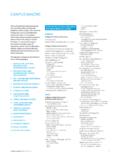Transcription of Domestic Terrorism: An Overview
1 Domestic Terrorism: An Overview Jerome P. Bjelopera Specialist in Organized Crime and Terrorism August 21, 2017 Congressional Research Service 7-5700 R44921 Domestic Terrorism: An Overview Congressional Research Service Summary The emphasis of counterterrorism policy in the United States since Al Qaeda s attacks of September 11, 2001 (9/11) has been on jihadist terrorism. However, in the last decade, Domestic terrorists people who commit crimes within the homeland and draw inspiration from extremist ideologies and movements have killed American citizens and damaged property across the country. Not all of these criminals have been prosecuted under federal terrorism statutes, which does not imply that Domestic terrorists are taken any less seriously than other terrorists.
2 The Department of Justice (DOJ) and the Federal Bureau of Investigation (FBI) do not officially designate Domestic terrorist organizations, but they have openly delineated Domestic terrorist threats. These include individuals who commit crimes in the name of ideologies supporting animal rights, environmental rights, anarchism, white supremacy, anti-government ideals, black separatism, and beliefs about abortion. The boundary between constitutionally protected legitimate protest and Domestic terrorist activity has received public attention. This boundary is highlighted by a number of criminal cases involving supporters of animal rights one area in which specific legislation related to Domestic terrorism has been crafted.
3 The Animal Enterprise Terrorism Act ( 109-374) expands the federal government s legal authority to combat animal rights extremists who engage in criminal activity. Signed into law in November 2006, it amended the Animal Enterprise Protection Act of 1992 ( 102-346). This report is intended as a primer on the issue, and four discussion topics in it may help explain Domestic terrorism s relevance for policymakers: Level of Activity. Domestic terrorists have been responsible for orchestrating numerous incidents since 9/11. Use of Nontraditional Tactics. A large number of Domestic terrorists do not necessarily use tactics such as suicide bombings or airplane hijackings. They have been known to engage in activities such as vandalism, trespassing, and tax fraud, for example.
4 Exploitation of the Internet. Domestic terrorists much like their jihadist analogues are often Internet and social-media savvy and use such platforms to share ideas and as resources for their operations. Decentralized Nature of the Threat. Many Domestic terrorists rely on the concept of leaderless resistance. This involves two levels of activity. On an operational level, militant, underground, ideologically motivated cells or individuals engage in illegal activity without any participation in or direction from an organization that maintains traditional leadership positions and membership rosters. On another level, the above-ground public face (the political wing ) of a Domestic terrorist movement may focus on propaganda and the dissemination of ideology engaging in protected speech.
5 Domestic Terrorism: An Overview Congressional Research Service Contents Introduction .. 1 Domestic Terrorism Defined .. 2 What Is Domestic Terrorism?.. 3 Toward a Narrower Definition .. 4 Ambiguity Regarding Extremist Ideologies .. 4 Factors Complicating the Descriptions of the Domestic Terrorism Threat .. 5 Counting Terrorism Cases .. 5 Sifting Domestic Terrorism from Other Illegal Activity .. 6 Extremism vs. Terrorism .. 8 The Lack of an Official Public List .. 9 Toward a Practical Definition: Threats Not Groups .. 10 Animal Rights Extremists and Environmental 11 Anarchist Extremists .. 13 White Supremacist Extremists .. 16 Anti-Government Extremists .. 23 Black Separatist Extremists .. 32 Abortion Extremists.
6 33 Protected Activities vs. Terrorism Divergent Perceptions of the ALF .. 35 A Serious Domestic Concern or Green Scare? .. 35 Assessing Domestic Terrorism s Significance .. 39 Counting Incidents .. 40 Nonviolent Strategies .. 41 Direct Action .. 41 The ALF: Live Liberations and Economic Sabotage .. 42 The ELF: Monkeywrenching .. 42 Paper Terrorism : Liens, Frivolous Lawsuits, and Tax Schemes .. 46 The Internet and Domestic Terrorists .. 48 A Decentralized Threat .. 50 Leaderless Resistance .. 50 Lone Wolves .. 53 Scoping the Threat Remains Difficult for Policymakers .. 57 Terminology .. 57 Designating Domestic Terrorist Groups .. 57 A Public Accounting of Plots and Incidents .. 58 Better Sense of Scope May Assist Policymakers.
7 59 Figures Figure 1. ALF and ELF Guidelines .. 45 Contacts Author Contact Information .. 59 Domestic Terrorism: An Overview Congressional Research Service 1 Introduction Since the terrorist attacks of September 11, 2001 (9/11), Domestic terrorists people who commit crimes within the homeland and draw inspiration from extremist ideologies and movements1 have not received as much attention from federal law enforcement as their violent jihadist counterparts. This was not necessarily always the case. The Federal Bureau of Investigation (FBI) reported in 1999 that [d]uring the past 30 years, the vast majority but not all of the deadly terrorist attacks occurring in the United States have been perpetrated by Domestic extremists.
8 2 The government reacted to 9/11 by greatly enhancing its counterterrorism efforts. This report discusses how Domestic terrorists broadly fit into the counterterrorism landscape, a terrain that since 9/11 has been largely shaped in response to terrorists inspired by foreign ideologies. This report focuses especially on how Domestic terrorism is conceptualized by the federal government and issues involved in assessing this threat s significance. Today (perhaps in part because of the government s focus on international terrorist ideologies), it is difficult to evaluate the scope of Domestic terrorist activity. For example, federal agencies employ varying terminology and definitions to describe it. Possibly contributing to Domestic terrorism s secondary status as a threat at the federal level, a large number of those labeled as Domestic terrorists do not necessarily use traditional terrorist tactics such as bombings or airplane hijackings.
9 Additionally, many Domestic terrorists do not intend to physically harm people but rather rely on alternative tactics such as theft, trespassing, destruction of property, and burdening courts with retaliatory legal filings. While plots and attacks by foreign-inspired homegrown violent jihadists have earned more media attention, Domestic terrorists have been busy as well. It is worth noting that in terms of casualties on soil, an act of Domestic terrorism is second only to the events of 9/11. Timothy McVeigh s bombing of the Alfred P. Murrah Federal Building in Oklahoma city on April 19, 1995, claimed 168 lives and injured more than 500 others. Some estimates suggest that Domestic terrorists are responsible for carrying out dozens of incidents since 9 Much like their jihadist counterparts, Domestic terrorists are often Internet savvy and use the medium as a resource for their operations.
10 Terrorists are typically driven by particular ideologies. In this respect, Domestic terrorists are a widely divergent lot, drawing from a broad array of philosophies and worldviews. These individuals can be motivated to commit crimes in the name of ideas such as animal rights, white supremacy, and abortion, for example. However, the expression of these worldviews (minus the commission of crimes) involves constitutionally protected activity. 1 This conceptualization of the term Domestic terrorism is derived from a number of government sources detailed in this report. This report will not focus on homegrown violent jihadists. However, when referring to such actors, for this report, homegrown describes terrorist activity or plots perpetrated within the United States or abroad by American citizens, permanent legal residents, or visitors radicalized largely within the United States.
















